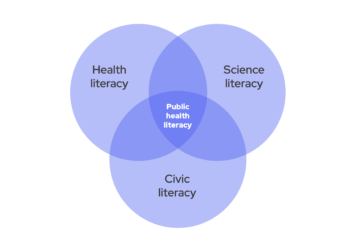Public Health Forward calls on health departments to formalize public health planning and processes that rely on input from, and share decision-making with, CBOs and the people they serve. Shared decision-making requires deliberate strategies to center the community’s expertise in all aspects of program planning, provide the space for meaningful dialogue, and develop shared priorities and actions that address the community’s self-identified needs.
A Plan to Share Power
When the Affordable Care Act community health needs assessment (CHNA) requirement was enacted, Lawrence + Memorial Hospital (L+M) and Ledge Light Health District (LLHD) in southeastern Connecticut agreed it would be mutually beneficial to collaborate on a CHNA and community health improvement plan (CHIP). The hospital had resources for a robust assessment, and the health department had data, expertise in analyzing community health needs, and strong connections with the community. The 2 organizations set up an advisory board with a wide range of community organizations and individual community members, which evolved into the Health Improvement Collaborative of Southeastern Connecticut (HIC). This group supports CHNA/CHIP work and shares a commitment to using a collective impact approach to address inequities through programmatic and systems-level change with a focus on dismantling racist structures.
Key Actions
Make structural changes to support process changes
Often in traditional governance structures, meetings are run and decision-making is led by people with a higher level of privilege than the community served. These structures reinforce existing power differentials, and changing them to incorporate people with lived experience into the leadership structure is critical to sharing decision-making power. The L+M and LLHD leads started as cochairs of the advisory board they established. As the advisory board expanded into HIC, the leaders recommended a self-selected co-ordinating team be established to support and guide HIC’s work between meetings. The coordinating team has 8 members, including the L+M and LLHD members.
Elicit feedback on group processes
Inviting people with lived experience to the table and asking them to vote on issues such as health priorities or actions to address them does not guarantee that shared decision-making will occur. Even in a well-established collaborative or committee, individuals may disengage, topics may be irrelevant to community members, discussions may contain too much professional jargon, power dynamics may elicit fear of voicing an opposing opinion, or other committee members may commit microaggressions toward community members with minority identities. Deliberately seeking feedback on decision-making processes can surface issues and concerns that may not be apparent to those who hold the power. In preparing for and holding a strategic planning retreat to kick off the coordinating team, a consultant interviewed coordinating team members and learned that some interviewees felt their participation was “tokenism” and that the L+M and LLHD leads held the power for the group.
Lead with humility
Make others’ lived experience and expertise the center of discussions about how to advance health equity. Taking this approach is key to embracing new decision-making processes in collaborations with CBOs and the communities they serve. The HIC currently is expanding its qualitative data collection, as the most recent CHNA is being finalized, to ensure sufficient information to characterize health inequities. Moreover, HIC is working to expand its reach to individual community members for their input on health priorities. Both actions center the community’s voice and directly or indirectly enhance shared decision-making for determining CHIP activities.
Jointly set up and commit to a decision-making process
It is important to cocreate a decision-making process that has the full support of those who will be using it. The process ideally centers lived experience and gives ample space for airing concerns. The coordinating team proposed a voting system in which members express their level of agreement with a 1 (low) to 5 (high) rating. Decisions pass if all votes are 3 or higher; anyone with a 1 rating explains their concerns to the group, and the group decides whether more discussion is needed or to advance the decision. The full HIC accepted this process, and members who had mostly been silent began to contribute more freely. The decision-making process is captured within a longer “Purpose and Procedures” (P&P) document, developed by a consultant and revised by the co-ordinating team. The P&P document then underwent a highly iterative process with the full HIC to ensure sufficient time for all members to understand and contribute to the final product. It took about 1 year to complete and is regarded by most, if not all, HIC members as an effort that was more important than any deadline related to the CHNA/CHIP work.
Respond appropriately to microaggressions
Deepening everyone’s understanding of and sensitivity to microaggressions provides a foundation for the open and honest conversations that are needed for a group to make well-informed decisions. Group members must be receptive to learning how what someone says and does can be dismissive and hurtful and how to respond in a way that promotes trust and understanding. Moreover, having open and honest discussions may necessitate surfacing and addressing microaggressions in real time. For people holding power, this work can be uncomfortable. For people of color, this work not only may be uncomfortable but can also trigger a stress response based on past trauma. Indeed, it might feel unsafe due to fear of consequences resulting from the discomfort experienced by people holding power. For these reasons, it is important for group members to develop a shared commitment to addressing microaggressions in a “safe space,” that is, an environment that is free from discrimination, criticism, harassment, defensiveness, or other negative repercussions.
This column was adapted from the Public Health Forward interactive implementation guide, featuring the stories of 10 state and local health departments. Explore the guide at www.publichealthforward.debeaumont.org.
Reference
1. Armooh T, Barton T, Castillo G, et al. Public Health Forward: Modernizing the U.S. Public Health System. Washington, DC: Bipartisan Policy Center; 2021. https://bipartisanpolicy.org/download/?file=/wp-content/uploads/2021/12/BPC_Public-Health-Forward_R01_WEB.pdf. Accessed January 27, 2023.
This column first appeared in the May/June 2023 issue of the Journal of Public Health Management & Practice. See the final authenticated version.





